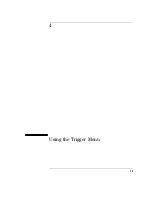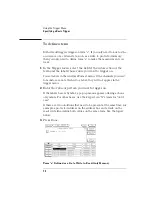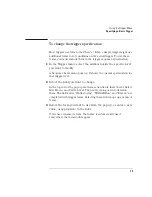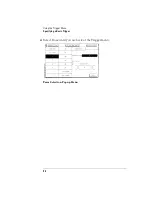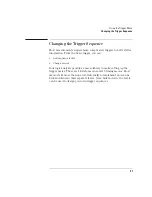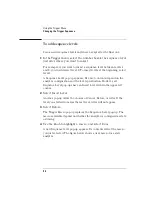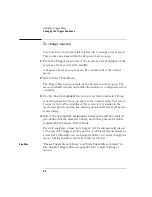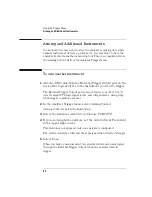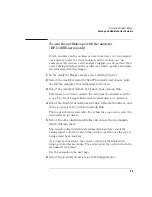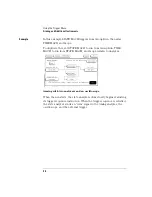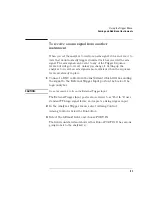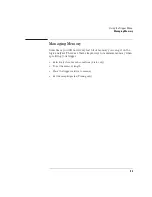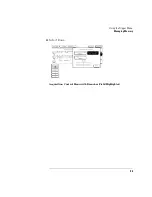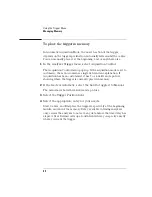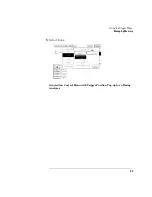
84
Using the Trigger Menu
Changing the Trigger Sequence
To change macros
You do not need to add and delete levels just to change a level’s macro.
This can be done from within the Sequence Level pop-up.
1
From the Trigger menu, select the sequence level number of the
sequence level you want to modify.
A Sequence Level pop-up appears. Its contents reflect the current
macro.
2
Select Select New Macro.
The Trigger Macro pop-up replaces the Sequence Level pop-up. The
macros available depend on whether the analyzer is configured as state
or timing.
3
Use the knob to highlight the macro you want, and select Done.
A new Sequence Level pop-up appears. Its contents reflect the macro
you just selected. The wording of this screen is very similar to the
macro description, and the line drawing demonstrates what the macro
is measuring.
4
Select the appropriate assignment fields and insert the desired
pre-defined terms, numeric values, and other parameter fields
required by the macro. Select Done.
For state analyzers, a final "go to trigger" level is automatically placed
at the end of the trigger specification for you. This level must always be
a user level. Although you can change its fields, you cannot change the
macro. Timing analyzers do not have this restriction.
See Also
"Timing Trigger Macro Library" and "State Trigger Macro Library" in
The Analyzer Trigger Menu on page 323 for a complete listing of
macros.
Summary of Contents for 1670E Series
Page 6: ...6 In This Book...
Page 26: ...26 Contents...
Page 27: ...27 Section 1 Logic Analyzer...
Page 28: ...28...
Page 29: ...29 1 Logic Analyzer Overview...
Page 39: ...39 2 Connecting Peripherals...
Page 49: ...49 3 Using the Logic Analyzer...
Page 72: ...72 Using the Logic Analyzer The Inverse Assembler...
Page 73: ...73 4 Using the Trigger Menu...
Page 101: ...101 5 Using the Oscilloscope...
Page 151: ...151 6 Using the Pattern Generator...
Page 199: ...199 7 Triggering Examples...
Page 237: ...237 8 File Management...
Page 249: ...249 9 Logic Analyzer Reference...
Page 360: ...360 Logic Analyzer Reference The Compare Menu...
Page 361: ...361 10 System Performance Analysis SPA Software...
Page 397: ...397 11 Logic Analyzer Concepts...
Page 430: ...430 Logic Analyzer Concepts The Analyzer Hardware Oscilloscope board theory Oscilloscope board...
Page 439: ...439 12 Troubleshooting the Logic Analyzer...
Page 455: ...455 13 Specifications...
Page 471: ...471 14 Operator s Service...
Page 479: ...479 Operator s Service Troubleshooting Troubleshooting Flowchart 2...
Page 491: ...491 Section 2 LAN...
Page 492: ...492...
Page 493: ...493 15 Introducing the LAN Interface...
Page 497: ...497 16 Connecting and Configuring the LAN...
Page 506: ...506 Connecting and Configuring the LAN Connecting and Configuring the LAN...
Page 507: ...507 17 Accessing the Logic Analyzer File System Using the LAN...
Page 515: ...515 18 Using the LAN s X Window Interface...
Page 527: ...527 19 Retrieving and Restoring Data Using the LAN...
Page 539: ...539 20 Programming the Logic Analyzer Using the LAN...
Page 546: ...546 Programming the Logic Analyzer Using the LAN Programming the Logic Analyzer Using the LAN...
Page 547: ...547 21 LAN Concepts...
Page 555: ...555 22 Troubleshooting the LAN Connection...
Page 580: ...580 Troubleshooting the LAN Connection Getting Service Support...
Page 581: ...581 Section 3 Symbol Utility...
Page 582: ...582...
Page 583: ...583 23 Symbol Utility Introduction...
Page 588: ...588 Symbol Utility Introduction Symbol Utility Introduction...
Page 589: ...589 24 Getting Started with the Symbol Utility...
Page 597: ...597 25 Using the Symbol Utility...
Page 609: ...609 26 Symbol Utility Features and Functions...




